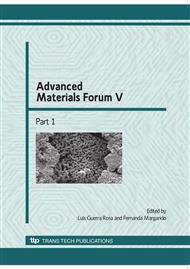p.1186
p.1194
p.1199
p.1206
p.1215
p.1222
p.1228
p.1234
p.1239
Elastic Work and Fracture Energy of Concretes Made with Crushed Stones and Pebbles Aggregates
Abstract:
This work examines the elastic work and fracture energy of a mortar and two concretes using the wedge splitting method to attain stable crack propagation. A comparison was made of the fracture energy in mortar and concrete using two different aggregates: crushed stone and pebbles, both with sizes between 4.8 and 9.5 mm. The mortar was made of sand, Portland cement and water, using a cement: sand ratio of 1:2. The water content was 0.46 of the cement mass. The samples were molded and then cured for seven days at 25oC in 100% relative humidity. After curing, the samples were dried at 55oC for 48 hours. The concretes were produced using the same procedure, but with the addition of the aggregates. The amount of aggregate was 10 wt.% of the total weight of cement plus sand. After curing and drying, the samples were subjected to the wedge splitting procedure. The tests were carried out at a constant displacement rate of 0.030 mm/min. The following results were obtained: elastic work: 80.4 ± 0.6, 114 ± 9 and 110 ± 12 mJ, and fracture energy: 30.3 ± 0.6, 40 ± 1, and 40 ± 5 J.m-2, respectively, for the mortar and for the concretes containing crushed stone and pebbles. These results allow us to conclude that the aggregates improved the elastic work and the fracture energy of the concretes. However, the type of aggregate did not make any difference to the properties. These findings contradict what is generally known, i.e., “that concrete produced with pebbles is inferior to concrete made with crushed stone”, at least insofar as it concerns the energies associated with the fracture process.
Info:
Periodical:
Pages:
1215-1221
Citation:
Online since:
January 2010
Authors:
Keywords:
Price:
Сopyright:
© 2010 Trans Tech Publications Ltd. All Rights Reserved
Share:
Citation:


